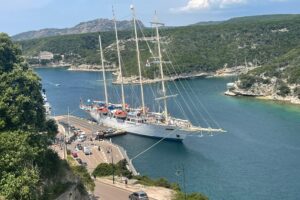Corsica offers beautiful scenery for biking
By Catherine Lutz
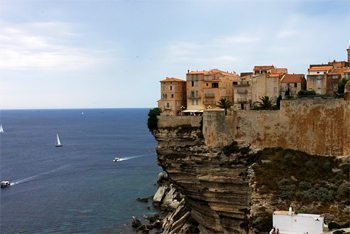
Stepping out of my tent clad in Lycra, I met the curious stares of my campground neighbors.
It was a hot sunny day on Corsica, the turquoise waves of the Mediterranean beckoning melodiously nearby and a cool breeze refreshing the sizzling air.
While the Europeans in camp finished their breakfast under shaded awnings and packed their beach bags for a full day of relaxing by the ocean, I had decided to tackle the hilly terrain of this island on a bicycle.
113-Miles x 51 miles
A small Mediterranean island only 113 miles long and 51 miles wide, Corsica boasts long stretches of white sand beaches on its gentle east coast and rugged shoreline of imposing cliffs and idyllic bays on the mountainous west coast.
In the rugged interior, more than 20 peaks soar over 6,540 feet. Tiny ancient villages scattered among the massif cling precariously to the hillsides. A wild thumb of land — Cap Corse — juts out north of the island, buffeted by the Mistral and other infamous winds.
Roads resembling cooked spaghetti ribbon 620 miles of the Corsican coastline. An island that experiences strong sunshine in the summer, with little precipitation and a consistent breeze, Corsica is the ideal place to cycle. Distances between towns are short and the scent of the maquis — Corsica’s ubiquitous wild flowering shrubs – add to the pleasure of an open-air adventure.
West Coast
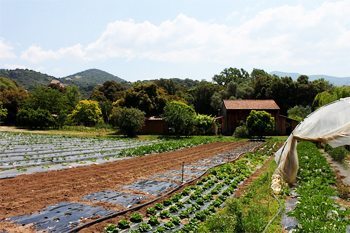 I started my journey with a day tour of the Balagne, a fertile, sparsely inhabited region in the northwest known as the “garden of Corsica.”
I started my journey with a day tour of the Balagne, a fertile, sparsely inhabited region in the northwest known as the “garden of Corsica.”
Climbing steadily inland on a narrow twisting road away from the port town of Ile-Rousse, I was rewarded with panoramic vistas over the curving haphazard Meditteranean shoreline.
Stopping at Sant Antonino, a picturesque cluster of stone houses on a rocky hilltop, I enjoyed fresh squeezed organic lemonade and a lunch of Corsican charcuterie and cheese on a terrace overlooking ripe vineyards. The road then follows the natural curves of the hilly valley, undulating up and down, winding in and out of the curving hillsides.
I passed several sleepy hamlets, among them Spelunkato, named for a natural rock tunnel that becomes mysteriously illuminated by sunlight – after sunset – two days a year. Belgodere is one of the largest towns in the region with a population of 330 and a good place to stop for ice cream.
On the mostly downhill cruise back to the campsite, the sun was sinking in the west, casting its golden rays on the bay’s brilliant waters. A steady, gratifyingly cool breeze increased in force and became a frustrating crosswind as I pedaled along the shore towards home.
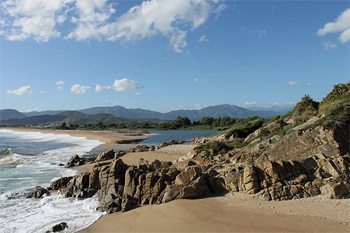 After a rest day – playing in the waves and lounging on the beach – I tackled the mostly straight, no-nonsense highway south to Calvi.
After a rest day – playing in the waves and lounging on the beach – I tackled the mostly straight, no-nonsense highway south to Calvi.
With some uphill but mostly down, I attained high speeds and completed the 12.5 mile stretch in a little over an hour.
While cycling parallel to Calvi’s famous 3.7-mile long beach, I often had to slow down or stop for groups of towel-toting tourists crossing the road to reach the sandy playground.
Calvi and Columbus
Calvi – situated in a protected bay surrounded by craggy peaks – was the principal city on Corsica during five hundred years of Genoese rule, and the last city to hold out against the French in the late 18th century battles over the island.
The citadel, crowning a rocky promontory in the bay, preserves its medieval charm with twisting cobblestone streets, crooked stairways, and imposing lookout towers. Calvi is rumored to be the birthplace of Christopher Columbus (along with several other Mediterranean cities), a claim emphatically supported by residents and commemorated with a small plaque on a modest house in the citadel.
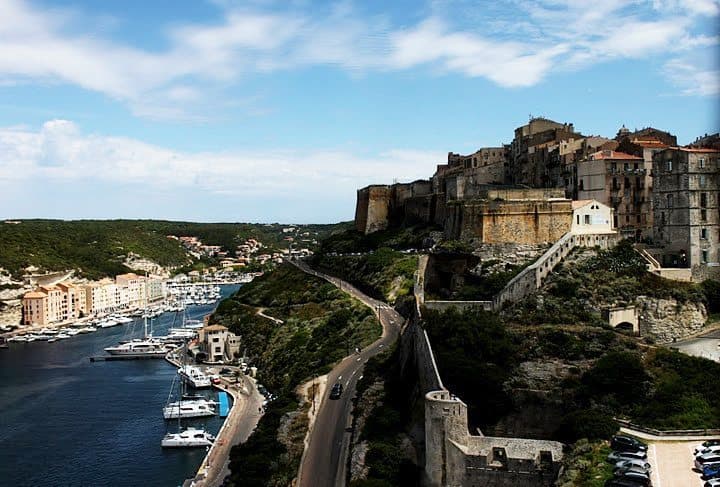
The road south from Calvi to Porto is well known to be the most scenic on Corsica. Here the narrow two lanes twist and snake along cliffsides, making their haphazard way around headlands overgrown with maquis or naked with deformed volcanic rock.
The population is scarce in this region; the only habitation I passed in several miles was a lone crumbling Napoleonic castle.
Detouring slightly from the coastal road, I rode inland a couple of miles along the Fango River. Originating from snowmelt high up the steep valley, this pure clear alpine stream tumbles a few miles to the sea over smooth boulders in a series of waterfalls and deep pools.
Cleansed of the sweat and grime of cycling, I could prepare for the next stage – a nine-mile, 1,300-foot climb towards the Col de Palmarella.
Twisting furiously, the road crosses the interior of the uninhabited Scandola peninsula, part of the 4,800-acre Reserve Naturelle de Scandola. La Scandola is a strictly maintained nature reserve and scientific study area for the island’s flora and fauna, extending over land and sea.

The grueling breezeless climb was made worthwhile by the view at the pass. Before me lay the Golfe de Girolata, bathed in the late afternoon sunshine, its resplendently serene waters a sparkling gold. The land surrounding the gulf is almost completely wild except for the tiny isolated hamlet of Girolata, accessible only by boat or foot, and the equally minuscule fishing port of Osani, where I chose to spend the night.
Under a trellis of passion fruit vines, I devoured my steak Frites and gulped local Corsican wine, utterly exhausted but completely satisfied.
The final 19 miles from Osani to Porto was mostly gentle going, a steady up and down. Here the cliffs fell more steeply and dramatically into the sea, and the traffic jams became more frequent on the tight road. Stone walls built from the cliff rock acted as barriers to prevent nasty swan dives into the boulder-strewn sea.
Spectacular Sunsets
The most spectacular sunsets on Corsica can be seen from Porto, although more adrenaline-pumping activities – such as scuba diving and hiking – are plentiful for the less sedate. Silhouetted against a late afternoon blood-red sky, Porto’s Genoese watchtower stands defiantly on a rocky outcropping.
The tower’s traditional role as part of an island-wide warning system and refuge for inhabitants during invasions is clearly unnecessary now, but it still stands as a reminder of Corsica’s tumultuous past and unique history.
The Interior
Corte, deep in the mountainous heart of the island, was the next stop on my itinerary. Turning inland from Porto, the road climbs almost 5,000 feet in 21 miles. Constantly curving left and right on a stretch of road literally blasted out of the granite, I could look back down at the bay–shimmering in the heat and surrounded by miles of craggy coast.
Emerging from the cool evergreen forests of the Spelunca Gorge, the dizzying heights of the central massif soon came into view.
Dominating the landscape, Monte Cinto at 8,849 feet is Corsica’s tallest peak. From these heights icy snowmelt is channeled through glacier-carved valleys, creating short but furious rivers.
Like many Corsican towns, Corte is perched on a rocky hilltop. Geographically at the center of the island, Corte is also at the center of the independence movement and holds Corsica’s only university.
The dilapidated crumbling buildings have an authentic charming air about them, and the city is as well known for the wealth of hiking trails in the surrounding valleys as for its rich cultural offerings. The narrow romantic Restonica Valley winds southwest from Corte along a crystal clear river of the same name.
From Corte I descended swiftly towards Ponte Leccia on a blessedly straight highway, then bore northwest towards Bastia through flattening lowlands. Castagniccia is Corsica’s prime chestnut growing region. Chestnuts are a staple here, ground into flour and consequently at the base of most bread and cakes. Wild groves of chestnut trees – also called bread trees – shade the landscape sloping towards the coast.
Cap Corse
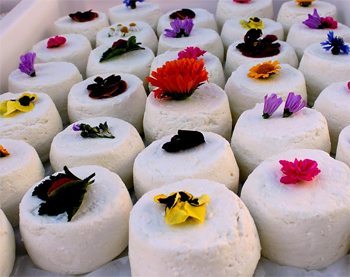
Coming into Bastia I was dazzled by the grandeur of the new port — no less than half a dozen large ferry boats and cruise ships towered over the docks.
Bastia boasts a population of 38,000, but this bustling city carries the energy and pride of a much larger European capital. In contrast to the new port, the old port sports rows of peeling old fishing boats, still taken out daily to earn a living for many residents.
Authentic restaurants serving Corsican specialties of the land and sea surround the old harbor – a must is a cannelloni a brocciu, pasta stuffed with soft sheep’s milk cheese, spinach, and spiced with maquis herbs.
Rugged Cap Corse
Rugged Cap Corse geographically apes the main bulk of Corsica. The peninsula’s eastern coast is gentle and smoothly rolling, the west wild and fierce and dominated by rocky wind-ravaged spits of land. Roughly 35 miles long and never more than 11 miles wide, it is spliced by a mountain chain that makes crossing its width only possible in two places.
Flowering maquis shrubs line both sides of the road as I left Bastia, heading up the east side of the peninsula. The scent led me through several quaint port towns spaced only a few miles apart, and over a pleasantly rolling landscape. Many ports on Cap Corse are actually half the town, dominated by a watchtower but sparsely inhabited. The other half can be found further inland – safely tucked away near a river source, and difficult to access by potential invaders.
Further north the countryside inland becomes wilder and the vegetation scrappier. Frequently ravaged by damaging fires fueled by constant strong winds during the dry summer months, much of the landscape lies scoured and barren. Whole crops are ruined, and the economy can be seriously impacted.
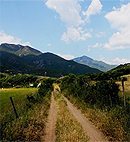 The coastal road turns inland at Macinaggio, a couple of miles from the island’s ragged northern edge. Climbing steadily above the low scrub I passed sleepy Rogliano, once a dominant town during the Genoese rule, but now marked only by crumbling castles and overgrown terraced fields.
The coastal road turns inland at Macinaggio, a couple of miles from the island’s ragged northern edge. Climbing steadily above the low scrub I passed sleepy Rogliano, once a dominant town during the Genoese rule, but now marked only by crumbling castles and overgrown terraced fields.
Battered by fierce winds and flying sand, the tiny fishing hamlet of Barcaggio is the northernmost settlement on Corsica. Out of curiosity, I descended the nine miles of rough curving road to the tip, but didn’t stay for long, imagining on my laborious climb back up how inhospitable this place must be in the winter.
The Descent

From the Col de Serra – the pass which separates the east and west sides of Cap Corse – I began to descend.
Far below, the angry ocean pounded the bottoms of glistening black cliffs and rolled over Volkswagen size boulders in the surf.
Seriously concerned that I’d get blown off the road by the hurricane-strength wind, I gritted my teeth, tightly gripped the handlebars, and set off down the perilous coastal road towards a campground – hopefully sheltered from the wind – near the fishing village of Centuri-Port.
That night I took a walk along the ocean. The half-moon illuminated the angry sea, turning the breaking waves an eerie shade of slate blue topped by sparkling white caps.
Rain Finally Comes
The next morning, heading towards Nonza, the sky was cloudy and thunder rumbled for the first time during my tour. When the rain finally fell, it lasted less than a half-hour and the sun was out in full force by mid-morning. I rode through sleepy villages, rows of maquis extending their flowering branches far out into my path.
The road cut across sheer cliffs, great slabs of gray-blue rock that mingled far below with bubbling black boulders. While eating lunch I watched a fire burn its way across the high scrubby hillside.
Nonza looks like it was carved from the cliff on which it is perched. Several buildings jut dangerously over the eroded stone outcropping. A square Genoese tower dominates the town’s profile. From the tower one can gaze out towards the Gulf of St. Florent at the base of Cap Corse, where deeper cobalt waters mingle with turquoise shallows.
Final Six Miles
The final six miles of my journey – a leisurely downhill glide – afforded expansive views of the gulf and its principal town, St. Florent. For the final three and a half miles, the road turns inland and meanders through Patrimonio, one of Corsica’s principal wine-growing regions.
On my last night, I attended a concert of the “Nuits de la Guitare” festival in the town of Patrimonio. While the flamenco guitar thrust out bold spirited chords and the accompanying singer passionately delivered his musical message to the crowd, I thought how appropriate it was that I was attending a flamenco concert my last night in Corsica.
The borrowed music mirrored the spirit of the island itself and highlighted the yin and yang – the pleasing harmony of opposites – that I had found throughout my journey here.
Length of ride: 250 miles
Difficulty: Moderate. The route is almost never flat, but the terrain guarantees as much downhill
as up, and the climbs are usually not too long.
Where the area is: In the Mediterranean Sea, 110 miles south of France and 50 miles west of Italy.
I cycled the northern half of the island in a roughly counter-clockwise circle.
Best time to go: Summers are very hot, but the dry climate and constant sea breeze make for pleasant cycling conditions. Late spring and early fall are good times to avoid most of the tourists, although that wasn’t a big concern on my bicycle route, and infrastructure (campgrounds, hotels, restaurants) greatly improves in the summer months. Winds throughout the seasons can cause fluctuations in climate, and the higher elevations are chilly with a chance of snow even in the
summer.
How to get there:
By airplane from most European cities to Ajaccio, Calvi or Bastia. By ferry from many harbors in Italy, Sardinia and France.
Other: Cost of living is comparable to much of southern Europe. Campgrounds are plentiful and have many amenities, hotels in some areas are rare. Corsica is very safe for travelers, even women alone, although common sense applies, like anywhere.
A GoNOMAD Photo Gallery By Catherine Lutz

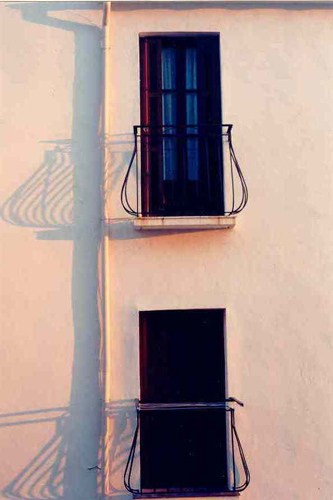
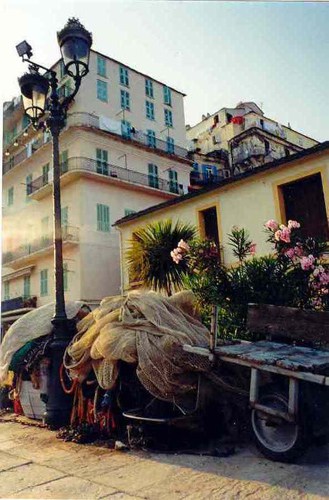
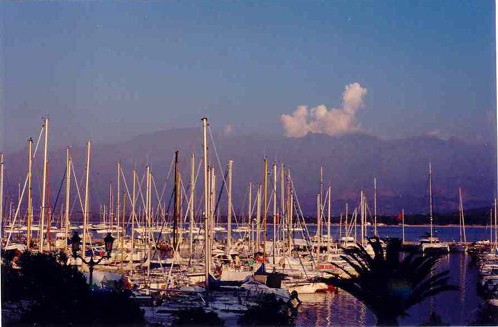
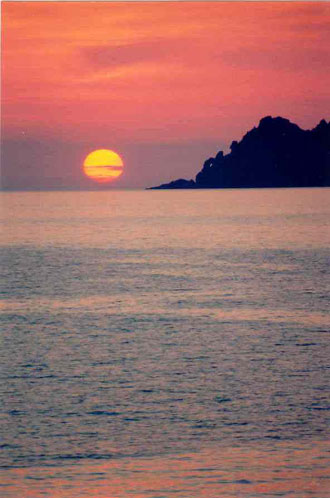

Catherine Lutz writes from Woody Creek, Colorado. She writes for a local newspaper and gets out whenever possible on bike, by foot or other transport that fits the bill.
Eurail Passes: What to Know about Buying a Europe Train Pass
- These 9 U.S. National Parks Require Reservations in 2024 - April 17, 2024
- Take a Hike in Olympic National Park - April 17, 2024
- The Wild Mississippi: 2340 Miles Across Ten States - April 8, 2024


